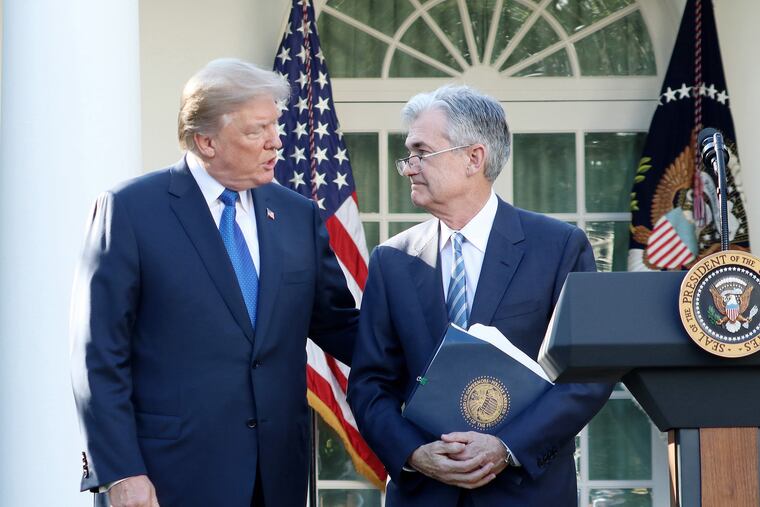Why Trump is wrong in blaming the Fed for his failure to achieve promised economic growth
Last year’s growth was temporarily juiced up by deficit-financed tax cuts. That is, the U.S. Treasury borrowed hundreds of billions of dollars more from global investors to cut a big check to corporations and mostly high-income and wealthy households.

President Donald Trump promised that his economic policies would jump-start much stronger economic growth. During the 2016 presidential campaign, he promised 3 percent growth, then 4 percent growth, and ultimately even 5 percent growth. If achieved, this would be game changing, as real GDP — the value of all the goods and services we produce — has experienced just over 2 percent growth since the end of the financial crisis nearly a decade ago.
The economy did enjoy stronger growth last year. It didn’t quite hit the president’s 3 percent bogey, but it got pretty close. Unfortunately, it didn’t last, and the economy’s growth has already throttled way back. This isn’t surprising, as last year’s growth was temporarily juiced up by deficit-financed tax cuts. That is, the U.S. Treasury borrowed hundreds of billions of dollars more last year from global investors to cut a big check to corporations and mostly high-income and wealthy households.
It didn’t take an astrophysicist to realize that that some of that money would be spent, and that this would pump things up, at least for a while. But the money is now largely spent, and the economy has slowed right back to the just over 2 percent growth that prevailed before the tax cuts. Three percent growth this year looks out of reach, and 4 percent or 5 percent is a pipe dream.
Trump isn’t happy, and he blames the Federal Reserve for the economy’s having fallen short. He has harangued policymakers at the Fed with tweets critical of their interest rate policy, demanding that the Fed cut interest rates. He is also clearly no fan of Fed Chairman Jerome Powell, whom he appointed to this position not more than a year ago.
The president is so upset with the Fed’s interest rate policy that he recently put forward two highly politicized and questionably qualified potential candidates for appointment to the Federal Open Market Committee, the interest-rate-setting committee of the Fed. One of those candidates has subsequently withdrawn from consideration, as several key Republican senators publicly stated that they would not support his nomination. The other candidate, who is ostensibly still in the running, is facing withering criticism from many quarters.
The president’s efforts are a clear affront to the Fed’s long-held and critically important independence from the political process. A key pillar of a well-functioning market economy is an independent central bank. This was learned the hard way over the decades as central banks captured by politics inevitably lose the trust of investors, businesses and households. Currencies are debased, inflation becomes unmanageable, and market interest rates rise.
Ironically, the president’s Fed bashing will, if anything, mean higher mortgage rates and lending rates for businesses. The Fed manages short-term interest rates but has little control over long-term rates, which are determined in the global bond market. If the Fed failed to raise short-term rates for political reasons, bond investors would sniff this out quickly and drive up long-term rates, as they would know that the value of their bonds would be undermined by the Fed’s actions.
None of this is to say that the Fed shouldn’t be accountable to the American people. To this end, the Fed has become increasingly transparent over the years on how it arrives at its interest rate decisions. Policymakers now have a clearly articulated framework and set of criteria for making policy. They explain their thinking in a formal statement at each FOMC meeting, and Chairman Powell recently began holding a news conference after each meeting to respond to journalists‘ questions. The Fed chairman also goes before Congress on a regular basis to hear legislators’ views on policy and take their questions.
The Fed’s decisions are also fair game for investors, economists and anyone else with a view on the conduct of monetary policy. Indeed, the Fed has recently been hit hard by progressive critics arguing that it has raised rates too early and too often since the financial crisis. They argue that the Fed has consistently underestimated the amount of slack in the economy — that there are more underemployed people than the Fed thinks — and that it is thus overly worried about inflation picking up. Regardless of one’s view on this policy issue, it is a good debate to have by those who can’t bend the Fed to their political will, and therapeutic for the Fed to hear.
My view is that the Fed’s current interest rate policy is spot on. After accounting for unemployment, inflation and expectations about future inflation, the stock market and other financial conditions, and how the economy is performing globally — all of the criteria the Fed says it considers when setting monetary policy — short-term rates are precisely where they should be.
There thus appears to be no evidence that Trump’s vitriol against the Fed has had an impact on its decision-making, and it is very unlikely to, because the principle of central bank independence from politics is deeply ingrained in the Fed’s culture. But the president is working hard to change this, and his actions bear close watching.